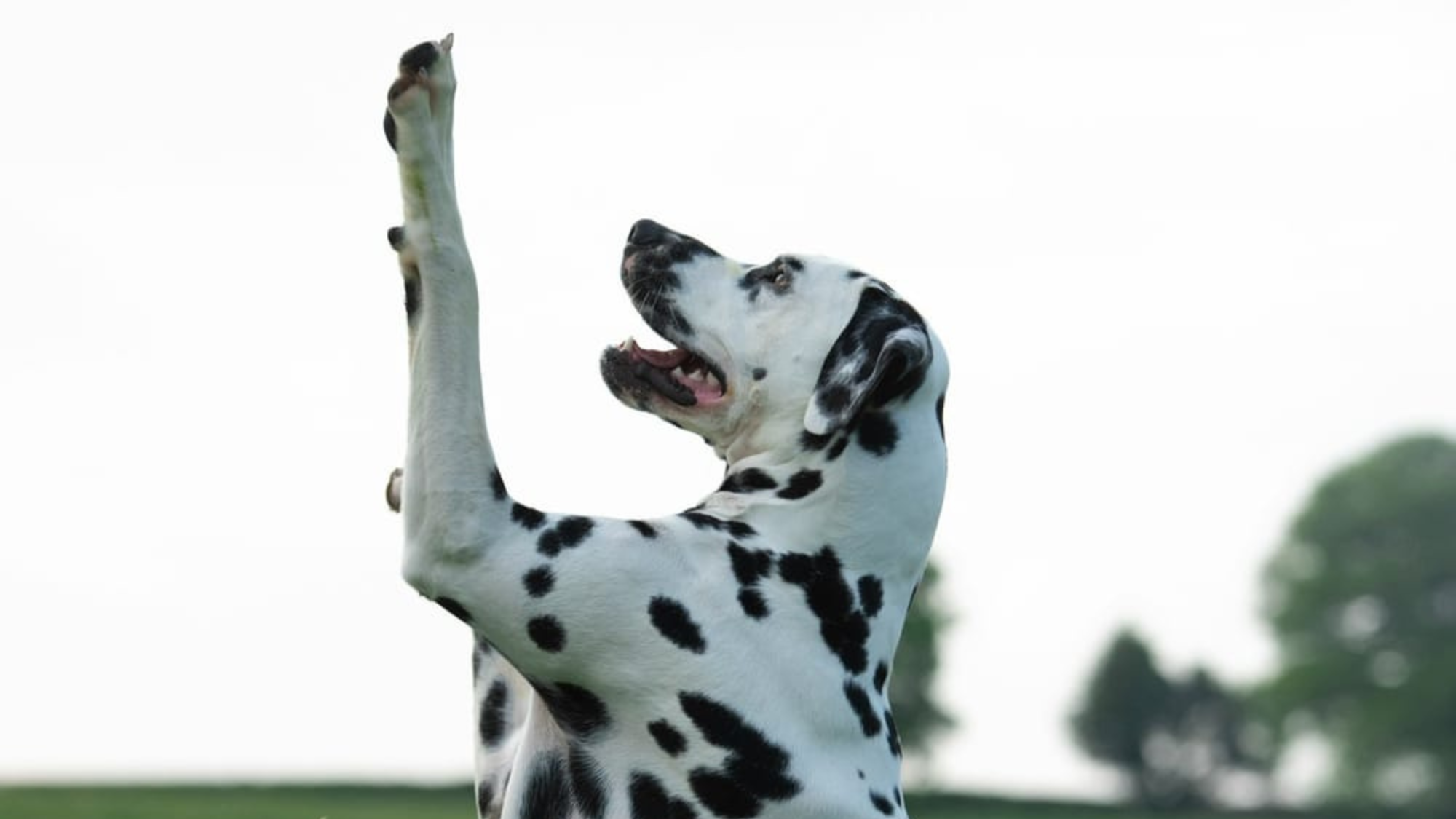Dalmatians, with their distinctive spotted coats and noble stature, have long captured the hearts of dog lovers worldwide. As a breed known for its energy and intelligence, a common question that surfaces among potential and current owners is: Can Dalmatians be left alone?
This question is not only crucial for those considering adopting a Dalmatian but also for current owners aiming to balance their lifestyle with the needs of their pet. Understanding a pet's ability to spend time alone is fundamental to ensuring their well-being and happiness. It's a topic that intertwines with the dog's mental health, behavior, and overall quality of life.

In this comprehensive exploration, we delve into various aspects that answer this pivotal question. We start by looking at the general temperament and specific needs of Dalmatians that influence their ability to be solitary. The article then moves to discuss the importance of companionship for these dogs and the potential impact of isolation.
We will explore the various factors that affect a Dalmatian's independence, such as age, training, and environment, and offer practical advice for creating a comfortable solo experience for them. Addressing common challenges and providing real-life success stories, this article aims to equip Dalmatian owners with the knowledge and tools to ensure their furry friends thrive, even when left on their own.
Understanding Dalmatians: A Brief Overview
The Dalmatian, a breed known as much for its striking spotted coat as its rich history, has origins shrouded in mystery. While the exact genesis of the breed is still debated, historical records and paintings suggest their presence in Europe, Asia, and Africa, with a strong association to the region of Dalmatia in modern-day Croatia. Originally bred for a variety of purposes including hunting, shepherding, and even as a status symbol among European nobility, Dalmatians have evolved to become beloved companions known for their distinct appearance and dignified demeanor.
In terms of temperament, Dalmatians are renowned for their high energy levels, intelligence, and loyalty. This breed is characteristically friendly and outgoing, often forming strong bonds with their human companions. However, their energetic and playful nature means they require regular exercise and mental stimulation to maintain their physical and mental health. Without adequate activity, a Dalmatian can become bored and restless, potentially leading to behavioral issues.
When considering the breed’s suitability for spending time alone, these characteristics play a significant role. Their intelligence, while a boon, also means Dalmatians can be prone to separation anxiety if not properly trained and conditioned for alone time. Their loyalty and bonding instincts can exacerbate this, leading to stress when separated from their owners. Moreover, their need for regular physical activity implies that long periods of solitude without adequate exercise can result in pent-up energy, often expressed through destructive behaviors or excessive barking.
Therefore, it is essential for potential and current Dalmatian owners to understand these traits. Effective training, establishing a routine, and providing sufficient exercise and mental engagement are key to ensuring that a Dalmatian can handle periods of solitude without adverse effects on their well-being. Recognizing and catering to these unique needs is vital in fostering a healthy, happy, and well-adjusted Dalmatian, capable of spending time alone without distress.
The Importance of Companionship for Dalmatians
Companionship holds a paramount place in the life of a Dalmatian. As a breed, Dalmatians are not just physically active but also socially inclined, thriving on interaction and engagement with their human families. Their historical roles as carriage dogs, running alongside horse-drawn carriages, and later as firehouse mascots, underline their propensity for companionship and activity. This inherent need for social interaction is not just a preference but a necessity for their emotional well-being.
The social needs of Dalmatians extend beyond the simple presence of others. They require meaningful engagement, which includes play, training, and affection. This interaction helps them establish a sense of security and belonging. A Dalmatian deprived of such interactions can experience a range of negative effects. Isolation, particularly for prolonged periods, can lead to signs of distress such as anxiety, depression, and destructive behavior. These can manifest in various forms, including excessive barking, chewing, and even self-harm in severe cases.

Experts and veterinarians often emphasize the impact of isolation on both the mental and physical health of Dalmatians. Mental stress in dogs, akin to humans, can lead to physical health issues. Stress can weaken the immune system, making them more susceptible to illnesses. Additionally, the lack of physical activity during periods of isolation can result in weight gain, muscle loss, and other health complications.
To mitigate these risks, experts advocate for a balanced approach. While it is understood that owners may need to leave their Dalmatians alone at times, ensuring that these periods are not excessively long is crucial. Moreover, supplementing alone time with quality interactive periods, where the dog's social and physical needs are met, is essential. Creating a structured routine, incorporating regular exercise, and even considering doggy daycare or dog walkers for longer absences can significantly contribute to a Dalmatian's overall well-being.
Factors Influencing a Dalmatian's Ability to Be Alone
The capacity of a Dalmatian to cope with solitude is not a one-size-fits-all matter; it is influenced by several key factors, including age and maturity, training and conditioning, and environmental considerations.
Age and Maturity: Puppies vs. Adult Dogs
The age of a Dalmatian greatly impacts its ability to be alone. Puppies, typically under the age of six months, are in the early stages of development and require more attention and care. They are learning to adapt to their environment, understand routines, and develop bladder control.
Leaving a puppy alone for extended periods can not only hinder these developmental processes but also contribute to anxiety and behavioral issues. In contrast, adult Dalmatians, with proper training, can be more adaptable to spending time alone. Their maturity allows them to handle solitude better, provided their needs for exercise and social interaction are met before and after periods of being alone.
Training and Conditioning: Preparing Your Dalmatian for Alone Time
Training and conditioning play a crucial role in preparing a Dalmatian for times of solitude. This process should start early, gradually increasing the time the dog spends alone, thereby conditioning them to understand that solitude is a normal part of their routine. Crate training can be particularly effective, as it creates a safe space for the dog. Positive reinforcement techniques, such as treats and praise when the dog remains calm and settled alone, reinforce good behavior. Training should also include activities that stimulate the dog's mind, helping to tire them out mentally and make them more inclined to rest while alone.
Environmental Factors: Space, Toys, and Comfort
The environment in which a Dalmatian is left alone can significantly affect their ability to handle solitude. A safe, comfortable space is essential. This means access to a secure area where they can move freely without the risk of injury or getting into trouble. Providing toys, especially those that are mentally stimulating like puzzle feeders, can help keep the dog engaged and prevent boredom. Comfort is also key; a comfortable bed, access to fresh water, and maintaining a suitable room temperature can make a significant difference in how a Dalmatian perceives its alone time.
Creating a positive alone-time environment is not about lavishness but about catering to the innate needs of the Dalmatian. This includes ensuring that the space is not only safe and comfortable but also stimulating. By addressing these factors, owners can significantly enhance their Dalmatian's ability to spend time alone, ensuring their time apart is as stress-free as possible for their beloved pet.
Creating a Safe and Comfortable Environment
Creating a safe and comfortable environment is a cornerstone of ensuring a positive experience for a Dalmatian left alone. The setup of this space and the activities provided beforehand can significantly impact their well-being and behavior.
Tips for Setting Up a Safe Space
The ideal environment for a Dalmatian should be secure, familiar, and stimulating. Start by choosing an area where your dog feels at ease, whether it's a specific room or a designated area within a room. Remove any potential hazards, such as electrical cords, toxic plants, or small objects that could be swallowed. Provide a comfortable bed or crate, especially if your Dalmatian has been crate trained, as it can offer a sense of security and privacy. Ensure that the space has adequate ventilation and is neither too hot nor too cold. Including a piece of clothing with your scent can also help soothe your dog in your absence.

Importance of Exercise and Activities Before Leaving Them Alone
Exercise is vital for a Dalmatian's physical and mental health, particularly before being left alone. A well-exercised dog is more likely to rest and be calm when alone. Engage your Dalmatian in physical activities like a long walk, run, or a play session before leaving. Mental stimulation is equally important. Puzzle toys, training exercises, or a game of hide-and-seek with treats can tire them out mentally, making them more inclined to relax.
Using Technology: Cameras, Automatic Feeders, etc.
In today's digital age, technology can play a significant role in monitoring and caring for your Dalmatian while you're away. Pet cameras allow you to watch and even interact with your dog remotely. Some cameras come with features like two-way audio, allowing you to talk to your pet, and treat dispensers to reward them. Automatic feeders can ensure your Dalmatian maintains their regular feeding schedule. Additionally, smart toys that can be controlled remotely can provide interactive playtime even when you're not there.
By considering these aspects, you create not just a safe space, but a nurturing environment that caters to the physical and emotional needs of your Dalmatian, making their time alone as comfortable and stress-free as possible.
Potential Challenges and Solutions
While Dalmatians can adapt to spending time alone, owners may encounter some challenges, such as separation anxiety and destructive behavior. Understanding how to identify and address these issues is crucial for the well-being of the dog and the peace of mind of the owner.
Common Issues: Separation Anxiety and Destructive Behavior
Separation anxiety is a prevalent issue in Dalmatians left alone. It manifests through symptoms such as excessive barking or howling, pacing, drooling, or attempts to escape. Destructive behavior is another common challenge, where the dog might chew on furniture, dig at doors or carpets, or destroy household items. These behaviors are often a response to stress or boredom.
Identifying and Addressing These Challenges
The first step in addressing these challenges is to recognize the signs early. Monitoring your Dalmatian’s behavior, possibly through a pet camera, can provide insights into their conduct when alone. Once identified, implementing a consistent routine can help. Gradually increasing the time your Dalmatian spends alone can acclimate them to your absence. Providing ample physical and mental stimulation before leaving can also mitigate these behaviors. For separation anxiety, creating a calm departure and return routine, without excessive fuss, can help minimize stress.
Using positive reinforcement techniques is key. Reward calm behavior with treats or affection, reinforcing the idea that being alone is not a negative experience. For destructive behavior, ensure that your Dalmatian has access to appropriate toys and chews to keep them occupied.
When to Seek Professional Help or Advice
If these strategies do not alleviate the issues, it may be time to seek professional help. Persistent signs of anxiety or destructive behavior warrant consulting a veterinarian or a professional dog behaviorist. They can provide tailored advice, which may include behavior modification techniques or, in some cases, medication to help manage anxiety.
Early intervention is important to prevent these behaviors from becoming ingrained habits. By being vigilant and proactive, most challenges related to a Dalmatian being left alone can be successfully managed, ensuring the health and happiness of both the dog and its owner.

Conclusion
In conclusion, while Dalmatians can adapt to spending time alone, this adaptation is contingent on several factors such as age, training, and the environment they are in. Understanding and addressing their need for companionship, exercise, and mental stimulation are crucial. Challenges like separation anxiety and destructive behavior can be managed with consistent training, routine, and, if needed, professional assistance. This journey underscores the essence of responsible and informed pet ownership. Balancing a Dalmatian's innate need for companionship with periods of independence is key, ensuring a harmonious and fulfilling relationship for both the pet and the owner.
FAQs
- Can Dalmatians be left alone for long periods?
- Dalmatians can be left alone, but the duration should be managed carefully. Prolonged periods of solitude can lead to issues like separation anxiety and destructive behavior.
- How long can you leave an adult Dalmatian alone?
- Adult Dalmatians, if properly trained, can be left alone for about 4-6 hours. It’s important to ensure they have been exercised and have access to water and a comfortable space.
- Do Dalmatian puppies require more attention compared to adults?
- Yes, Dalmatian puppies require more attention and should not be left alone for more than 2 hours, as they are still developing and learning routines.
- What are common signs of separation anxiety in Dalmatians?
- Common signs include excessive barking, pacing, chewing on inappropriate items, and attempts to escape.
- How can I train my Dalmatian to be comfortable alone?
- Gradually increase their alone time, use positive reinforcement, ensure they have adequate exercise, and provide mental stimulation through toys and puzzles.
- Are there any environmental factors that help Dalmatians stay calm when alone?
- A comfortable bed, access to water, safe toys, and a secure space are essential. A familiar environment with minimal stressors helps keep them calm.
- Can technology help in monitoring a Dalmatian when I'm not home
- Yes, pet cameras, automatic feeders, and interactive toys can be useful in monitoring and engaging your Dalmatian when you’re away.
- When should I seek professional help for my Dalmatian’s separation anxiety?
- If consistent training doesn’t improve their behavior, or if the anxiety seems severe, consult a veterinarian or a professional dog behaviorist.
- Is it okay to crate a Dalmatian when leaving them alone?
- Yes, if your Dalmatian is crate trained and finds the crate comforting, it can be a safe space for them when alone.
- How important is exercise for a Dalmatian before leaving them alone?
- Very important. Adequate exercise can help expend their energy, making them more likely to rest while you’re away.




